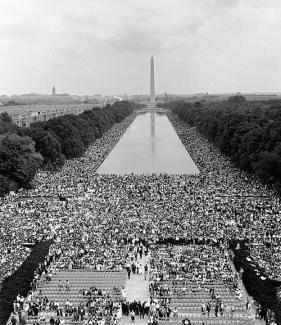Anniversary of the 1963 March on Washington for Jobs and Freedom

Photo by a United States Marine / Wikimedia Commons
Hundreds of thousands descended on Washington, D.C.'s, Lincoln Memorial and the National Mall around the Lincoln Memorial Reflecting Pool on August 28, 1963. It was from the steps of the Lincoln Memorial that King delivered his famous “I Have a Dream” speech. King's many speeches and nonviolent actions were instrumental in shaping the nation's outlook on equality.
Origins of the 1963 March on Washington for Jobs and Freedom
The 1963 March on Washington for Jobs and Freedom is one of history’s most significant civil rights events in the United States. One of the key catalysts for the march was the continued segregation and discrimination faced by African Americans, as well as a series of violent confrontations in the South, including the Birmingham campaign. Civil rights leaders and organizations, including Dr. Martin Luther King Jr., A. Philip Randolph, and Bayard Rustin, played pivotal roles in organizing the event.
A. Philip Randolph, a respected labor leader and civil rights activist, had proposed a mass march on the nation's capital to demand economic and civil rights for African Americans as early as the 1940s. In 1963, this idea gained significant momentum as various civil rights groups, religious organizations, and concerned citizens joined forces. The March on Washington aimed to address not only racial segregation and discrimination but also the economic disparities that disproportionately affected African Americans.
Cultural Significance
The 1963 March on Washington is best known for being the setting where Dr. Martin Luther King Jr. delivered his iconic "I Have a Dream" speech. This speech articulated the vision of a more just and equitable society, where individuals are judged by the content of their character rather than the color of their skin. The march was attended by an estimated 250,000 people of all races, making it one of the largest political rallies for civil rights in American history. Its nonviolent nature and diverse, peaceful assembly were emblematic of the principles of the civil rights movement. The march also played a crucial role in putting pressure on the government to enact meaningful civil rights legislation.
Implications for Ending Racism
The 1963 March on Washington for Jobs and Freedom led to the passage of significant civil rights legislation, including the Civil Rights Act of 1964 and the Voting Rights Act of 1965. These laws aimed to dismantle institutionalized segregation and discrimination and secure voting rights for African Americans. The march demonstrated the power of nonviolent resistance, mass mobilization, and the importance of public awareness in the fight against racism.
Additionally, the march served as an inspiration for subsequent generations of activists and advocates. It emphasized the need for unity and collaboration across racial and ethnic lines to combat racial inequality. The 1963 March on Washington for Jobs and Freedom remains a symbol of hope and progress in the ongoing pursuit of racial justice and equality in the United States.
